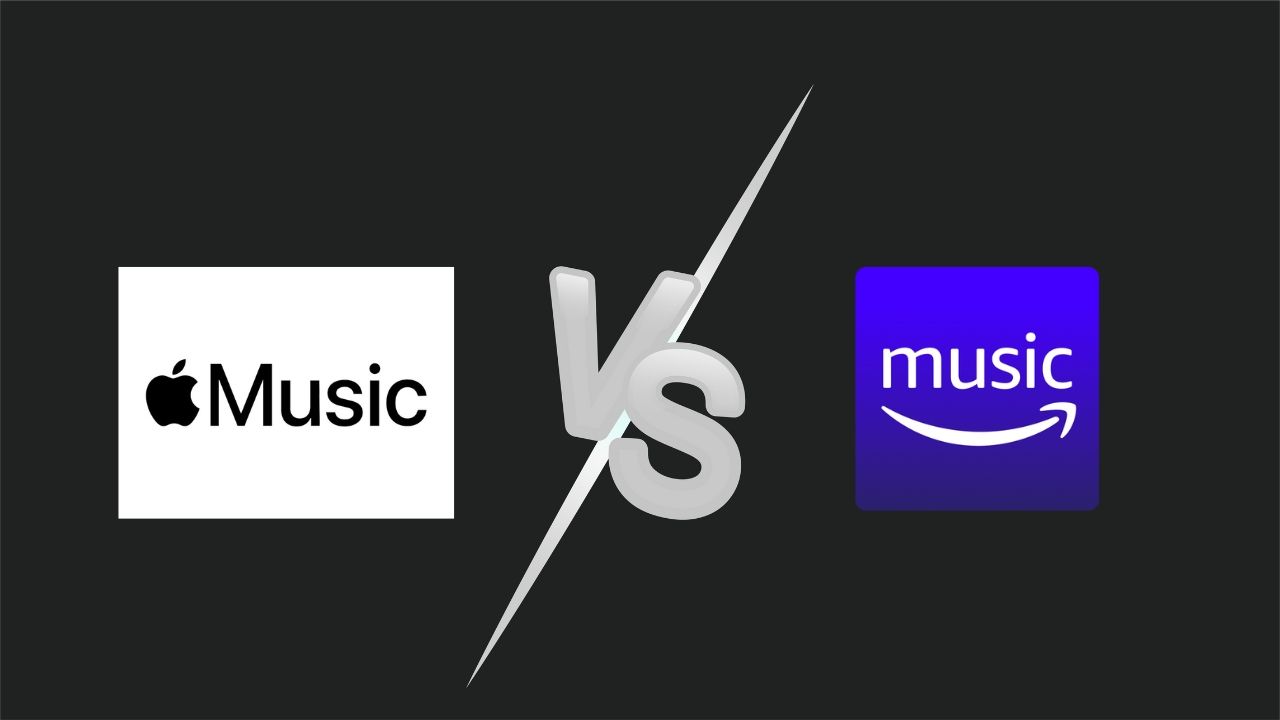In the rapidly evolving world of music streaming services, Amazon Music vs Apple Music has emerged as a frequent topic of discussion. Both platforms offer vast music libraries, exclusive content, and various features designed to enhance the user experience. However, deciding between Amazon Music vs Apple Music can be challenging. This blog will explore the differences and similarities between Amazon Music vs Apple Music, helping you make an informed choice.
Introduction to Music Streaming Services
Music streaming services have revolutionized how we consume music. Gone are the days of purchasing individual albums or songs; now, you can access millions of tracks with just a few taps on your device. Among the plethora of options available, Amazon Music vs Apple Music stands out for their extensive libraries, seamless integration with devices, and unique features that cater to diverse audiences.
In recent years, the popularity of music streaming has skyrocketed, with millions of users worldwide embracing the convenience of accessing vast music libraries from anywhere. Amazon Music vs Apple Music represents two of the biggest names in this space, each offering unique features that appeal to different types of listeners. Whether you’re a casual listener or a hardcore audiophile, understanding the nuances of Amazon Music vs Apple Music can help you decide which service best fits your lifestyle.
Music Library
One of the most critical aspects to consider in the Amazon Music vs Apple Music debate is the size and diversity of their music libraries. Apple Music boasts over 90 million tracks, making it one of the most comprehensive music libraries available. This vast selection includes everything from mainstream hits to obscure tracks. On the other hand, Amazon Music offers more than 75 million songs. While slightly less than Apple Music, it still provides a substantial library. Both services ensure that their users can access nearly any song they might want.
Beyond just numbers, the quality and diversity of content in the Amazon Music vs Apple Music libraries are also worth noting. Apple Music has strong ties with artists and record labels, often providing exclusive content and early releases. This makes it a go-to platform for fans who want to stay ahead of the curve. In contrast, Amazon Music offers a more curated selection of podcasts and additional content, catering to users who enjoy a broader range of audio experiences. The Amazon Music vs Apple Music library comparison highlights that while both services have extensive offerings, your choice may depend on your taste and what additional content you value.
Pricing and Plans
When comparing Amazon Music vs Apple Music, pricing is a crucial factor. Apple Music offers an individual plan at ₹99 per month, with a family plan for ₹149 per month. They also provide a student discount, reducing the price to ₹49 per month. In contrast, Amazon Music has its Music Unlimited plan priced at ₹129 per month for individual users. Amazon Prime members can access Amazon Music Prime for free, albeit with a reduced library of 2 million songs. For ₹129 per month, Prime members can upgrade to Amazon Music Unlimited, unlocking the full library. The Amazon Music vs Apple Music price comparison highlights that both services offer competitive plans, but the choice depends on your specific needs.
It’s also worth mentioning that Amazon Music sometimes offers promotional deals, such as discounts for Prime members or extended free trials. On the other hand, Apple Music occasionally provides extended free trials for new users, particularly when purchasing new Apple devices. This aspect of the Amazon Music vs Apple Music comparison is significant because it can influence your decision depending on the promotions available when you decide to subscribe. The flexibility in pricing and occasional discounts in the Amazon Music vs Apple Music debate adds another layer of consideration for potential subscribers.
Sound Quality
Sound quality is a significant consideration in the Amazon Music vs Apple Music comparison. Apple Music has introduced lossless audio and spatial audio with Dolby Atmos, offering a high-fidelity listening experience that is hard to beat. These features make Apple Music a leader in audio quality. On the other hand, Amazon Music offers HD and Ultra HD audio as part of its Music Unlimited subscription, which provides a similar high-quality audio experience. Both services offer 3D audio options, making the Amazon Music vs Apple Music debate more about personal preference rather than a clear winner in sound quality.
Moreover, Amazon Music goes a step further by offering 3D audio on select tracks, similar to Apple’s spatial audio. For audiophiles, this feature is crucial, as it allows a more immersive listening experience. The battle between Amazon Music vs Apple Music in terms of sound quality is intense, with both services pushing the boundaries to provide the best audio experience possible. If you’re someone who values top-notch sound, exploring these options in Amazon Music vs Apple Music might help you find the perfect fit for your listening preferences.
User Interface and Experience
Another important aspect of the Amazon Music vs Apple Music comparison is the user interface. Apple Music is known for its clean and minimalist design, particularly on iOS devices. The app is user-friendly and emphasizes curation and discovery, making it easy for users to find new music. Conversely, Amazon Music offers a more functional interface, which, while not as polished as Apple’s, still provides an easy-to-navigate experience. The Amazon Music vs Apple Music user experience depends on whether you prioritize a sleek design or functional simplicity.
For instance, Apple Music offers a seamless integration with Siri, allowing voice commands to play specific songs, albums, or playlists. This integration enhances the overall experience, particularly for users who are already invested in the Apple ecosystem. On the other hand, Amazon Music shines with its integration with Alexa. The ability to control music playback hands-free is a major convenience for users, especially those who have smart homes equipped with Amazon Echo devices. The Amazon Music vs Apple Music user interface comparison ultimately boils down to the ecosystem you’re more invested in, as both services provide intuitive and user-friendly interfaces.
Device Compatibility and Integration
Device compatibility is where Amazon Music vs Apple Music shows clear differences. Apple Music integrates deeply into the Apple ecosystem, making it ideal for users with multiple Apple devices. It works seamlessly across iPhones, iPads, Macs, and even the Apple Watch. However, Apple Music is also available on Android devices, though the experience is slightly limited. On the other hand, Amazon Music is available on a broader range of devices, including iOS, Android, Windows, Mac, and smart TVs. The service is particularly well-suited for those who use Alexa-enabled devices, making it a key consideration in the Amazon Music vs Apple Music debate.
For users with smart homes, the compatibility of Amazon Music vs Apple Music with various smart devices can be a decisive factor. Amazon Music integrates smoothly with a wide array of smart home devices, particularly those that use Alexa. This allows users to control their music with simple voice commands, adding a layer of convenience that is hard to match. Conversely, Apple Music is tailored for those deeply embedded in the Apple ecosystem, offering seamless experiences across all Apple devices. The comparison in this context is a matter of choosing the service that aligns with your device preferences.
Exclusive Content and Features
When evaluating Amazon Music vs Apple Music, exclusive content plays a significant role. Apple Music is known for its exclusive releases and early access to new albums, providing users with content they can’t find elsewhere. Additionally, Apple Music offers Apple Music 1 radio, featuring shows hosted by famous artists and DJs. On the other hand, Amazon Music offers original podcasts and some exclusive content, including AutoRip, which gives users free digital versions of CDs purchased from Amazon. The Amazon Music vs Apple Music comparison in exclusive content shows that both services offer unique benefits depending on your content preferences.
Exclusive content can be a major draw for music fans who want to access special releases or artist interviews. Apple Music has a long history of working closely with artists to provide exclusive content, making it a top choice for fans who want to be the first to hear new music. Meanwhile, Amazon Music is increasingly investing in exclusive podcasts and other original content, which can be a deciding factor for users who enjoy diverse audio entertainment. The debate in terms of exclusive content is all about what kind of content you value more—music exclusives or a broader range of audio content.
Offline Listening and Downloads
Offline listening is a crucial feature in the Amazon Music vs Apple Music debate. Both services allow users to download music for offline listening, which is essential for users who are frequently on the go. Apple Music lets users download songs, albums, and playlists for offline access, which syncs across all their Apple devices. Similarly, Amazon Music provides offline listening options, with downloads accessible as long as the subscription is active. The Amazon Music vs Apple Music offline listening comparison shows that both services offer robust offline capabilities, ensuring that your music is always available.
When it comes to managing your offline content, both Amazon Music and Apple Music offer intuitive solutions. Apple Music makes it easy to organize downloaded content by playlists, albums, and artists, with seamless syncing across all Apple devices. This means you can start listening to a song offline on your iPhone and continue where you left off on your iPad or Mac. Amazon Music similarly offers easy management of offline content, with the added benefit of Alexa integration, allowing you to control playback of your downloaded music with voice commands.
One notable difference in the Amazon Music vs Apple Music offline listening feature is how they handle storage management. Apple Music offers users the ability to optimize storage by automatically removing downloads that haven’t been played in a while, freeing up space on your device. Amazon Music allows users to download content in various quality levels, which can help manage storage usage, especially on devices with limited space. This makes an interesting comparison for users who need to balance their music library with device storage constraints.
For those considering family plans, the Amazon Music vs Apple Music comparison is quite relevant. Apple Music offers a family plan for ₹149 per month, allowing up to six members to share a subscription. Each member gets their own personalized account, complete with individual recommendations and playlists. In contrast, Amazon Music provides a family plan at ₹199 per month, also allowing up to six members to share. Like Apple Music, each member has their own account and personalized experience. The family plan comparison reveals that both services offer excellent value for families.
The flexibility offered by these family plans in the Amazon Music vs Apple Music debate is a significant advantage, particularly for households with multiple users who have different music preferences. Apple Music excels in providing a seamless experience across all Apple devices, making it a natural choice for families already invested in the Apple ecosystem. On the other hand, Amazon Music offers the added benefit of integration with Amazon’s other services, such as Prime Video and Kindle, making it a more comprehensive option for families who use a variety of Amazon services. The family plan comparison ultimately comes down to the specific needs and preferences of your household.
Music Discovery and Personalization
Music discovery is a strong point in the Amazon Music vs Apple Music debate. Apple Music excels with its human-curated playlists and personalized recommendations. The For You section of Apple Music is particularly effective in suggesting new music based on your listening habits. This feature makes it easier for users to explore new genres, artists, and albums they might not have discovered otherwise. Additionally, Apple Music’s algorithm takes into account your favorite artists, songs, and genres, continuously refining its suggestions to better match your tastes.
On the other hand, Amazon Music relies more on algorithmic suggestions, which are powered by your listening habits and preferences. The integration with Alexa also enhances music discovery, as you can simply ask Alexa to play music based on your mood or preferences, such as “Alexa, play some relaxing music,” or “Alexa, play songs I might like.” This hands-free convenience can be particularly appealing for users who enjoy discovering new music without actively searching for it. The comparison in terms of music discovery shows that both services excel in different ways, with Apple focusing on curated content and Amazon leveraging powerful algorithms and voice commands.
Podcasts and Additional Content
In the Amazon Music vs Apple Music discussion, podcasts and additional content are worth considering. Apple Music users can access podcasts through the Apple Podcasts app, which is separate but well-integrated into the Apple ecosystem. This separation allows Apple to maintain a dedicated space for music, while offering a robust platform for podcast lovers. Apple Podcasts is one of the largest podcast platforms globally, offering millions of episodes across all genres.
Amazon Music, however, integrates podcasts directly into its platform, making it easy to switch between music and podcasts without leaving the app. This integrated approach can be more convenient for users who prefer a one-stop-shop for all their audio content. Amazon’s podcast library is extensive and includes some exclusives, which can be a major draw for podcast enthusiasts. The comparison in terms of podcasts highlights that Amazon Music might be more convenient for users who frequently switch between different types of audio content, while Apple’s separate approach may appeal to those who prefer to keep their music and podcasts distinct.
Music Videos and Visual Content
Another factor in the Amazon Music vs Apple Music debate is the availability of music videos and other visual content. Apple Music offers a rich selection of music videos, live performances, and exclusive video content from artists. This visual content is integrated into the platform, allowing users to watch music videos or live concerts alongside their regular music streaming. Apple Music also offers curated music video playlists, making it easy to find videos that match your taste or mood.
Amazon Music does not focus as heavily on music videos, though it does offer some visual content, particularly through its integration with Prime Video. Users who subscribe to both services can easily access a wealth of visual content, including documentaries and live performances related to their favorite artists. The comparison in terms of visual content shows that Apple Music has a more robust offering in this area, making it a better choice for users who enjoy consuming music-related videos alongside their audio tracks.
Which Service Is Right for You?
Choosing between Amazon Music vs Apple Music ultimately depends on your personal preferences, the devices you use, and how you consume music and other audio content. If you are deeply embedded in the Apple ecosystem, Apple Music is likely the better choice due to its seamless integration, high-quality audio options, and exclusive content. The intuitive user interface and human-curated playlists make it an excellent option for those who appreciate a polished, well-rounded music experience.
However, if you are an Amazon Prime member or heavily use Alexa-enabled devices, Amazon Music might be the better fit. The integration with Amazon’s other services, such as Prime Video and Alexa, makes it a comprehensive choice for users who value convenience and cross-platform compatibility. Additionally, the ability to control music through voice commands and the availability of HD and Ultra HD audio quality are strong points in favor of Amazon Music.
For families, the decision may come down to which ecosystem the household is more invested in, as both services offer excellent family plans with personalized accounts for each member. Whether you prioritize sound quality, device compatibility, exclusive content, or music discovery features, understanding the nuances of Amazon Music vs Apple Music will help you make an informed choice that best suits your needs.
Conclusion
In the battle of Amazon Music vs Apple Music, each service has its strengths and caters to different user bases. Apple Music shines with its polished interface, high-quality audio, and deep integration with the Apple ecosystem. It’s a top choice for those who value a seamless user experience and access to exclusive content. The inclusion of features like lossless audio and spatial audio with Dolby Atmos further enhances its appeal, particularly for audiophiles.
On the other hand, Amazon Music offers great value, especially for Prime members, and a robust voice-controlled experience with Alexa. Its integration with other Amazon services and broader device compatibility make it an excellent choice for users who value flexibility and cross-platform functionality. Whether you’re an audiophile seeking the best sound quality or a family looking for a shared music experience, it offers compelling options for all types of listeners.
Ultimately, the best service for you depends on your specific needs, the devices you use, and your preferences for music discovery, exclusive content, and additional features. This comparison shows that both services are excellent platforms for enjoying your favorite music, each with its own unique strengths.
For further reading, explore these related articles:
- How to Make a VEVO Music Video: A Step-by-Step Guide for Artists
- Understanding Music Charts & Insights: A Guide for Aspiring Musicians
- The Power of Playlist Push Curators: Boost Your Music Career
For additional resources on music marketing and distribution, visit Deliver My Tune.






